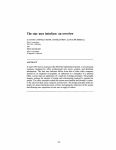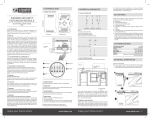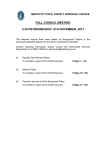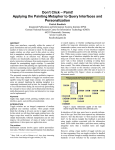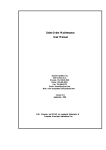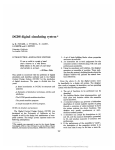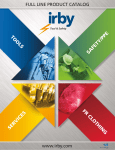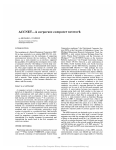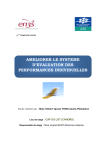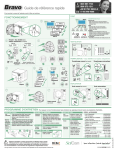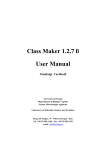Download The star user interface: an overview
Transcript
The star user interface: an overview
by DAVID CANFIELD SMITH, CHARLES IRBY, and RALPH KIMBALL
Xerox Corporation
Palo Alto, California
and
ERIC HARSLEM
Xerox Corporation
EI Segundo, California
ABSTRACT
In April 1981 Xerox announced the 8010 Star Information System, a new personal
computer designed for office professionals who create, analyze, and distribute
information. The Star user interface differs from that of other office computer
systems by its emphasis on graphics, its adherence to a metaphor of a physical
office, and its rigorous application of a small set of design principles. The graphic
imagery reduces the amount of typing and remembering required to operate the
system. The office metaphor makes the system seem familiar and friendly; it reduces the alien feel that many computer systems have. The design principles unify the
nearly two dozen functional areas of Star, increasing the coherence of the system
and allowing user experience in one area to apply in others.
515
From the collection of the Computer History Museum (www.computerhistory.org)
From the collection of the Computer History Museum (www.computerhistory.org)
The Star User Interface: An Overview
INTRODUCTION
In this paper we present the features in the Star system without justifying them in detail. In a companion paper, 1 we discuss the rationale for the design decisions made in Star. We
assume that the reader has a general familiarity with computer
text editors, but no familiarity with Star.
The Star hardware consists of a processor, a two-page-wide
bit-mapped display, a keyboard, and a cursor control device.
The Star software addresses about two dozen functional areas
of the office, encompassing document creation; data processing; and electronic filing, mailing, and printing. Document creation includes text editing and formatting, graphics
editing, mathematical formula editing, and page layout. Data
processing deals with homogeneous databases that can be
sorted, filtered, and formatted under user control. Filing is an
example of a network service using the Ethernet local area
network. 2,3 Files may be stored on a work station's disk (Figure 1), on a file server on the work station's network, or on a
file server on a different network. Mailing permits users of
work stations to communicate with one another. Printing uses
laser-driven xerographic printers capable of printing both text
and graphics. The term Star refers to the total system, hardware plus software.
As Jonathan Seybold has written, "This is a very different
product: Different because it truly bridges word processing
517
and typesetting functions; different because it has a broader
range of capabilities than anything which has preceded it; and
different because it introduces to the commercial market radically new concepts in human engineering.,,4
The Star hardware was modeled after the experimental
Alto computer developed at the Xerox Palo Alto Research
Center. 5 Like Alto, Star consists of a Xerox-developed highbandwidth MSI processor, local disk storage, a bit-mapped
display screen having a 72-dot-per-inch resolution, a pointing
device called the mouse, and a connection to the Ethernet.
Stars are higher-performance machines than Altos, being
about three times as fast, having 512K bytes of main memory
(vs. 256K bytes on most Altos), 10 or 29M bytes of disk
memory (vs. 2.5M bytes), a 101/2-by-131/2-inch display screen
(vs. a lOh-by-82-inch one), 1024 x 808 addressable screen
dots (vs. 606 x 808), and a 10M bits-per-second Ethernet (vs.
3M bits). Typically, Stars, like Altos, are linked via Ethernets
to each other and to shared file, mail, and print servers. Communication servers connect Ethernets to one another either
directly or over phone lines, enabling internetwork communication to take place. This means, for example, that from the
user's perspective it is no harder to retrieve a file from a file
server across the country than from a local one.
Unlike the Alto, however, the Star user interface was designed before the hardware or software was built. Alto software, of which there was eventually a large amount, was developed by independent research teams and individuals.
There was little or no coordination among projects as each
pursued its own goals. This was acceptable and even desirable
in a research environment producing experimental software.
But it presented the Star designers with the challenge of synthesizing the various interfaces into a single, coherent, uniform one.
ESSENTIAL HARDWARE
Before describing Star's user interface, we should point out
that there are several aspects of the Star (and Alto) architecture that are essential to it. Without these elements, it would
have been impossible to design a user interface anything like
the present one.
Display
Figure I-A Star workstation showing the processor, display, keyboard and
mouse
Both Star and Alto devote a portion of main memory to the
bit-mapped display screen: lOOK bytes in Star, 50K bytes
(usually) in Alto. Every screen dot can be individually turned
on or off by setting or resetting the corresponding bit in
memory. This gives both systems substantial ability to portray
graphic images.
From the collection of the Computer History Museum (www.computerhistory.org)
518
National Computer Conference, 1982
Memory Bandwidth
Local Disk
Both Star and Alto have a high memory bandwidth-about
50 MHz, in Star. The entire Star screen is repainted from
memory 3~ times per second. This 50-MHz video rate would
s\vamp most computer memories, and in fact refreshing the
screen takes about 60% of the Alto's memory bandwidth.
However, Star's memory is double-ported; therefore, refreshing the display does not appreciably slow down CPU memory
access. Star also has separate logic devoted solely to refreshing the display.
Every Star and Alto has its own rigid disk for local storage
of programs and data. Editing does not require using the
network. This enhances the personal nature of the machines,
resulting in consistent behavior regardless of how many other
machines there are on the network or what anyone else is
doing. Large programs can be written, using the disk for
swapping.
Network
Microcoded Personal Computer
Both Star and Alto are personal computers, one user per
machine. Therefore the needed memory access and CPU cycles are consistently available. Special microcode has been
written to assist in changing the contents of memory quickly,
permitting a variety of screen processing that would otherwise
not be practical. 6
Mouse
Both Star and the Alto use a pointing device called the
mouse (Figure 2). First developed at SRI/ Xerox's version
has a ball on the bottom that turns as the mouse slides over a
flat surface such as a table. Electronics sense the ball rotation
and guide a cursor on the screen in corresponding motions.
The mouse is a "Fitts's law" device: that is, after some practice
The Ethernet lets both Stars and Altos have a distributed
architecture. Each machine is connected to an Ethernet.
Other machines on the Ethernet are dedicated as servers,
machines that are attached to a resource and that provide
access to that resource. Typical servers are these:
1. File server-Sends and receives files over the network,
storing them on its disks. A file server improves on a
work station's rigid disk in several ways: (a) Its capacity
is greater-up to 1.2 billion bytes. (b) It provides backup
facilities. (c) It allows files to be shared among users.
Files on a work station's disk are inaccessible to anyone
else on the network.
2. Mail server-Accepts files over the network and distributes them to other machines on behalf of users, employing the Clearinghouse's database of names and addresses (see below).
3. Print server-Accepts print-format files over the network and prints them on the printer connected to it.
4. Communication server-Provides several services: The
Clearinghouse service resolves symbolic names into network addresses.1O The Internetwork Routing service
manages the routing of information between networks
over phone lines. The Gateway service allows word processors and dumb terminals to access network resources.
A network-based server architecture is economical, since
many machines can share the resources. And it frees work
stations for other tasks, since most server actions happen in
the background. For example, while a print server is printing
your document, you can edit another document or read your
mail.
PHYSICAL OFFICE METAPHOR
Figure 2-The Star keyboard and mouse
The keyboard has 24 easy-to-understand function keys. The mouse has two
buttons on top.
you can point with a mouse as quickly and easily as you can
with the tip of your finger. The limitations on pointing speed
are those inherent in the human nervous system. 8,9 The mouse
has buttons on top that can be sensed under program control.
The buttons let you point to and interact with objects on the
screen in a variety of ways.
We will briefly describe one of the most important principles
that influenced the form of the Star user interface. The reader
is referred to Smith et al. 1 for a detailed discussion of all the
principles behind the Star design. The principle is to apply
users' existing knowledge to the new situation of the computer. We decided to create electronic counterparts to the
objects in an office: paper, folders, file cabinets, mail boxes,
calculators, and so on-an electronic metaphor for the physical office. We hoped that this would make the electronic
world seem more familiar and require less training. (Our initial experiences with users have confirmed this.) We further
decided to make the electronic analogues be concrete objects.
From the collection of the Computer History Museum (www.computerhistory.org)
The Star User Interface: An Overview
Star documents are represented, not as file names on a disk,
but as pictures on the display screen. They may be selected by
pointing to them with the mouse and clicking one of the
mouse buttons. Once selected, documents may be moved,
copied, or deleted by pushing the MOVE, COPY, or DELETE key on the keyboard. Moving a document is the electronic equivalent of picking up a piece of paper and walking
somewhere with it. To file a document, you move it to a
picture of a file drawer, just as you take a piece of paper to a
physical filing cabinet. To print a document, you move it to a
picture of a printer, just as you take a piece of paper to a
copying machine.
Though we want an analogy with the physical world for
familiarity, we don't want to limit ourselves to its capabilities.
One of the raisons d' hre for Star is that physical objects do not
provide people with enough power to manage the increasing
complexity of their information. For example, we can take
advantage of the computer's ability to search rapidly by providing a search function for its electronic file drawers, thus
helping to solve the problem of lost files.
519
contents of folders and file drawers, see what mail has arrived,
and perform other activities. Windows are the principal mechanism for displaying and manipulating information.
- The Desktop-surface is displayed as a distinctIve grey pattern. This is restful and makes the icons and windows on it
stand out crisply, minimizing eye strain. The surface is organized as an array of I-inch squares, 14 wide by 11 high. An
icon may be placed in any square, giving a maximum of 154
icons. Star centers an icon in its square, making it easy to line
up icons neatly. The Desktop always occupies the entire display screen; even when windows appear on the screen, the
Desktop continues to exist "beneath" them.
The Desktop is the principal Star technique for realizing the
physical office metaphor. The icons on it are visible, concrete
embodiments of the corresponding physical objects. Star
users are encouraged to think of the objects on the Desktop
in physical terms. You can move the icons around to arrange
your Desktop as you wish. (Messy Desktops are certainly
possible, just as in real life. ) You can leave documents on your
Desktop indefinitely, just as on a real desk, or you can file
them away.
THE DESKTOP
ICONS
Every user's initial view of Star is the Desktop, which resembles the top of an office desk, together with surrounding furniture and equipment. It represents a working environment,
where current projects and accessible resources reside. On the
screen (Figure 3) are displayed pictures of familiar office objects, such as documents, folders, file drawers, in-baskets, and
out-baskets. These objects are displayed as small pictures, or
icons.
You can "open" an icon by selecting it and pushing the
OPEN key on the keyboard. When opened, an icon expands
into a larger form called a window, which displays the icon's
contents. This enables you to read docuplents, inspect the
An icon is a pictorial representation of a Star object that can
exist on the Desktop. On the Desktop, the size of an icon is
approximately 1 inch square. Inside a window such as a folder
window, the size of an icon is approximately Y4-inch square.
Iconic images have played a role in human communication
from cave paintings in prehistoric times to Egyptian hieroglyphics to religious symbols to modern corporate logos.
Computer science has been slow to exploit the potential of
visual imagery for presenting information, particularly abstract information. "Among [the] reasons are the lack of
development of appropriate hardware and software for producing visual imagery easily and inexpensiVely; computer
technology has been dominated by persons who seem to be
happy with a simple, very limited alphabet of characters used
to produce linear strings of symbols."l1 One of the authors has
applied icons to an environment for writing programs; he
found that they greatly facilitated human-computer communication. 12 Negroponte's Spatial Data Management system
has effectively used iconic images in a research setting. 13 And
there have been other efforts. 14,15,16 But Star is the first computer system designed for a mass market to employ icons
methodically in its user interface. We do not claim that Star
exploits visual communication to the ultimate extent; we do
claim that Star's use of imagery is a significant improvement
over traditional human-machine interfaces.
At the highest level the Star world is divided into two classes
of icons, (1) data and (2) function icons:
Data Icons
Figure 3-A "Desktop" as it appears on the Star screen
This one has several commonly used icons along the top, including documents to
serve as ''form pad" sources for letters, memos and blank paper. There is also an
open window displaying a document.
Data icons (Figure 4) represent objects on which actions are
performed. All data icons can be moved, copied, deleted,
filed, mailed, printed, opened, closed, and have a variety of
other operations performed on them. The three types of data
icons are document, folder, and record file.
From the collection of the Computer History Museum (www.computerhistory.org)
520
National Computer Conference, 1982
Figure 4---The "data" icons: document, folder and record file
Figure 5-A file drawer icon
Document
A document is the fundamental object in Star. It corresponds to the standard notion of what a document should be.
It most often contains text, but it may also include illustrations, mathematical formulas, tables, fields, footnotes, and
formatting information. Like all data icons, documents can be
shown on the screen, rendered on paper, sent to other people,
stored on a file server or floppy disk, etc. When opened,
documents are always rendered on the display screen exactly
as they print on paper (informally called "what you see is what
you get"), including displaying the correct type fonts, multiple
columns, headings and footings, illustration placement, etc.
Documents can reside in the system in a variety of formats
(e.g., Xerox 860, IBM OS6), but they can be edited only in
Star format. Conversion operations are provided to translate
between the various formats.
Folder
A folder is used to group data icons together. It can contain
documents, record files, and other folders. Folders can be
nested inside folders to any level. Like file drawers (see below), folders can be sorted and searched.
containing other folders. File drawers are distinguished from
other storage places (folders, floppy disks, and the Desktop)
in that (1) icons placed in a file drawer are physically stored
on a file server, and (2) the contents of file drawers can be
shared by multiple users. File drawers have associated access
rights to control the ability of people to look at and modify
their contents (Figure 6).
Although the design of file drawers was motivated by their
physical counterparts, they are a good example of why it is
neither necessary nor desirable to stop with just duplicating
real-world behavior. People have a lot of trouble finding
things in filing cabinets. Their categorization schemes are frequently ad hoc and idiosyncratic. If the person who did the
categorizing leaves the company, information may be permanently lost. Star improves on physical filing cabinets by
taking advantage of the computer's ability to search rapidly.
You can search the contents of a file drawer for an object
having a certain name, or author, or creation date, or size, or
a variety of other attributes. The search criteria can use fuzzy
patterns containing match-anything symbols, ranges, and
other predicates. You can also sort the contents on the basis
of those criteria. The point is that whatever information retrieval facilities are available in a system should be applied to
Record file
A record file is a collection of information organized as a set
of records. Frequently this information will be the variable
data from forms. These records may be sorted, subset via
pattern matching, and formatted into reports. Record files
provide a rich set of information storage and retrieval
functions.
Function Icons
Function icons represent objects that perform actions. Most
function icons will operate on any data icon. There are many
kinds of function icons, with more being added as the system
evolves:
File drawer
A file drawer (Figure 5) is a place to store data icons. It is
modeled after the drawers in office filing cabinets. The organization of a file drawer is up to you; it can vary from a
simple list of documents to a multilevel hierarchy of folders
Figure 6---An open file drawer window
Note that there is a miniature icon for each object inside the file drawer.
From the collection of the Computer History Museum (www.computerhistory.org)
The Star User Interface: An Overview
the information in files. Any system that does not do so is not
exploiting the full potential of the computer.
In basket and Out basket
These provide the principal mechanism for sending data
icons to other peopie (Figure 7). A data icon placed in the Out
basket will be sent over the Ethernet to a mail server (usually
the same machine as a file server), thence to the mail servers
ofthe recipients (which may be the same as the sender's), and
thence to the In baskets of the recipients. When you have mail
waiting for you, an envelope appears in your In basket icon.
When you open your In basket, you can display and read the
mail in the window.
Any document, record file, or folder can be mailed. Documents need not be limited to plain text, but can contain illustrations, mathematical formulas, and other nontext material.
Folders can contain any number of items. Record files can be
arbitrarily large and complex.
521
ing, in a different city, even in a different country. You perform exactly the same actions to print on any of them: Select
a data icon, push the MOVE key, and indicate the printer icon
as the destination.
Floppy disk drive
The floppy disk drive icon (Figure 9) allows you to move
data icons to and from a floppy disk inserted in the machine.
This provides a way to store documents, record files and folders off line. When you open the floppy disk drive icon, Star
reads the floppy disk and displays its contents in the window.
Its window looks and acts just like a folder window: icons may
be moved or copied in or out, or deleted. The only difference
is the physical location of the data.
Figure 7-ln and Out basket icons
Figure 9-A floppy disk drive icon
User
Printer
Printer icons (Figure 8) provide access to printing services.
The actual printer may be directly connected to your work
station, or it may be attached to a print server connected to an
Ethernet. You can have more than one printer icon on your
Desktop, providing access to a variety of printing resources.
Most printers are expected to be laser-driven raster-scan xerographic machines; these can render on paper anything that
can be created on the screen. Low-cost typewriter-based
printers are also available; these can render only text.
As with filing and mailing, the existence of the Ethernet
greatly enhances the power of printing. The printer represented by an icon on your Desktop can be in the same room
as your work station, in a different room, in a different build-
The user icon (Figure 10) displays the information that the
system knows about each user: name, location, password
(invisible, of course), aliases if any, home file and mail servers, access level (ordinary user, system administrator, help/
training writer), and so on. We expect the information stored
for each user to increase as Star adds new functionality. User
icons may be placed in address fields for electronic mail.
User icons are Star's solution to the naming problem. There
is a crisis in computer naming of people, particularly in electronic mail addressing. The convention in most systems is to
Figure 8--A printer icon
Figure lO-A user icon
From the collection of the Computer History Museum (www.computerhistory.org)
522
National Computer Conference, 1982
use last names for user identification. Anyone named Smith,
as is one of the authors, knows that this doesn't work. When
he first became a user on such a system, Smith had long ago
been taken. In fact, "D. Smith" and even "D. C. Smith" had
been taken. He finally settled on "DaveSmith", all one word,
with which he has been stuck to this day. Needless to say, that
is not how he identifies himself to people. In the future, people will not tolerate this kind of antihumanism from computers. Star already does better: it follows society's conventions.
User icons provide unambiguous unique references to individual people, using their normal names. The information about
users, and indeed about all network resources, is physically
stored in the Clearinghouse, a distributed database of names.
In addition to a person's name in the ordinary sense, this
information includes the name of the organization (e.g., Xerox, General Motors) and the name of the user's division
within the organization. A person's linear name need be
unique only within his division. It can be fully spelled out if
necessary, including spaces and punctuation. Aliases can be
defined. User icons are references to this information. You
need not even know, let alone type, the unique linear representation for a user; you need only have the icon.
Calculator
A variety of styles of calculators (Figure 12) let you perform
arithmetic calculations. Numbers can be moved between Star
documents and calculators, thereby reducing the amount of
typing and the possibility of errors. Rows or columns of tables
can be summed. The calculators are user-tailorable and extensible. Most are modeled after pocket calculators-business,
scientific, four-function-but one is a tabular calculator similar to the popular Visicalc program.
User group
Figure 12-A calculator icon
User group icons (Figure 11) contain individual users and/
or other user groups. They allow you to organize people according to various criteria. User groups serve both to control
Terminal emulators
The terminal emulators permit you to communicate with
existing mainframe computers using existing protocols. Initially, teletype and 3270 terminals are emulated, with additional ones later (Figure 13). You open one of the terminal
icons and type into its window; the contents of the window
behave exactly as if you were typing at the corresponding
terminal. Text in the window can be copied to and from Star
documents, which makes Star's rich environment available to
them.
Figure ll-A user group icon
access to information such as file drawers (access control lists)
and to make it easy to send mail to a large number of people
(distribution lists). The latter is becoming increasingly important as more and more people start to take advantage of
computer-assisted communication. At Xerox we have found
that as soon as there were more than a thousand Alto users,
there were almost always enough people interested in any
topic whatsoever to form a distribution list for it. These user
groups have broken the bonds of geographical proximity that
have historically limited group membership and communication. They have begun to turn Xerox into a nationwide
"village," just as the Arpanet has brought computer science
researchers around the world closer together. This may be the
most profound impact that computers have on society.
Figure 1>-3270 and 1TY emulation icons
Directory
The Directory provides access to network resources. It
serves as the source for icons representing those resources;
the Directory contains one icon for each resource available
(Figure 14). When you are first registered in a Star network,
From the collection of the Computer History Museum (www.computerhistory.org)
The Star User Interface: An Overview
Figure 14--A Directory icon
your Desktop contains nothing but a Directory icon. From
this initial state, you access resources such as file drawers,
printers, and mail baskets by opening the Directory and copying out their icons. You can also get blank data icons out of the
Directory. You can retrieve other data icons from file drawers. Star places no limits on the complexity of your Desktop
except the limitation imposed by physical screen area (Figure
15). The Directory also contains Remote Directories representing resources available on other networks. These can be
opened, recursively, and their resource icons copied out, just
as with the local Directory. You deal with local and remote
resources in exactly the same way.
523
came from Alan Kay's Flex machine 17 and his later Smalltalk
programming environment on the AltO.18 The Officetalk
treatment of windows was also influential; in fact, Officetalk,
an experimental office-forms-processing system on the Alto,
provided ideas in a variety of areas. 19 Windows greatly increase the amount of information that can be manipulated on
a display screen. Up to six windows at a time can be open in
Star. Each window has a header containing the name of the
icon and a menu of commands. The commands consist of a
standard set present in all windows ("?" , CLOSE, SET WINDOW) and others that depend on the type of icon. For example, the window for a record file contains commands tailored
to information retrieval. CLOSE removes the window from
the display screen, returning the icon to its tiny size. The "?"
command displays the online documentation describing the
type of window and its applications.
Each window has two scroll bars for scrolling the contents
vertically and horizontally. The scroll bars have jump-to-end
areas for quickly going to the top, bottom, left, or right end
of the contents. The vertical scroll bar also has areas labeled
Nand P for quickly getting the next or previous screenful of
the contents; in the case of a document window, they go to the
next or previous page. Finally, the vertical scroll bar has a
jumping area for going to a particular part of the contents,
such as to a particular page in a document.
Unlike the windows in some Alto programs, Star windows
do not overlap. This is a deliberate decision, based on our
observation that many Alto users were spending an inordinate
amount of time manipulating windows themselves rather than
their contents. This manipulation of the medium is overhead,
and We want to reduce it. Star automatically partitions the
display space among the currently open windows. You can
control on which side of the screen a window appears and its
height.
PROPERTY SHEETS
Figure 15---The Directory window, showing the categories of resources
available
The important thing to observe is that although the functions performed by the various icons differ, the way you interact with them is the same. You select them with the mouse.
You push the MOVE, COPY, or DELETE key. You push the
OPEN key to see their contents, the PROPERTIES key to see
their properties, and the SAME key to copy their properties.
This is the result of rigorously applying the principle of uniformity to the design of icons. We have applied it to other
areas of Star as well, as will be seen.
WINDOWS
Windows are rectangular areas that display the contents of
icons on the screen. Much of the inspiration for Star's design
At a finer grain, the Star world is organized in terms of objects
that have properties and upon which actions are performed. A
few examples of objects in Star are text characters, text paragraphs, graphic lines, graphic illustrations, mathematical summation signs, mathematical formulas, and icons. Every object
has properties. Properties of text characters include type
style, size, face, and posture (e.g., bold, italic). Properties of
paragraphs include indentation, leading, and alignment.
Properties of graphic lines include thickness and structure
(e.g., solid, dashed, dotted). Properties of document icons
include name, size, creator, and creation date. So the properties of an object depend on the type of the object. These ideas
are similar to the notions of classes, objects, and messages in
Simula20 and Smalltalk. Among the editors that use these
ideas are the experimental text editor Brav0 21 and the experimental graphics editor Draw, 22 both developed at the Xerox
Palo Alto Research Center. These all supplied valuable
knowledge and insight to Star. In fact, the text editor aspects
of Star were derived from Bravo.
In order to make properties visible, we invented the notion
of a property sheet (Figure 16). A property sheet is a twodimensional formlike environment which shows the proper-
From the collection of the Computer History Museum (www.computerhistory.org)
524
National Computer Conference, 1982
Figure 16-The property sheet for text characters
ties of an object. To display one, you select the object of
interest using the mouse and push the PROPERTIES key on
the keyboard. Property sheets may contain three types of
parameters:
1. State-State parameters display an independent property, which may be either on or off. You turn it on or off
by pointing to it with the mouse and clicking a mouse
button. When on, the parameter is shown video reversed. In general, any combination of state parameters
in a property sheet can be on. If several state parameters
are logically related, they are shown on the same line
with space between them. (See "Face" in Figure 16.)
2. Choice-Choice parameters display a set of mutually
exclusive values for a property. Exactly one value must
be on at all times. As with state parameters, you turn on
a choice by pointing to it with the mouse and clicking a
mouse button. If you turn on a different value, the system turns off the previous one. Again the one that is on
is shown video reversed. (See "Font" in Figure 16.) The
motivation for state and choice parameters is the observation that it is generally easier to take a multiple-choice
test than a fill-in-the-blanks one. When options are
made visible, they become easier to understand, remember, and use.
3. Text-Text parameters display a box into which you can
type a value. This provides a (largely) unconstrained
choice space; you may type any value you please, within
the limits of the system. The disadvantage of this is that
the set of possible values is not visible; therefore Star
uses text parameters only when that set is large. (See
"Search for" in Figure 17.)
Property sheets have several important attributes:
1. A small number of parameters gives you a large number
of combinations of properties. They permit a rich choice
space without a lot of complexity. For example, the character property sheet alone provides for 8 fonts, from 1 to
6 sizes for each (an average of about 2), 4 faces (any
Figure 17-The option sheet for the Find command
combination of which can be on), and 8 positions relative to the baseline (including OTHER, which lets you
type in a value). So in just four parameters, there are
over 8 x 2 X 24 X 8 = 2048 combinations of character
properties.
2. They show all of the properties of an object. None is
hidden. You are constantly reminded what is available
every time you display a property sheet.
3. They provide progressive disclosure. There are a large
number of properties in the system as a whole, but you
want to deal with only a small subset at anyone time.
Only the properties of the selected object are shown.
4. They provide a "bullet-proof' environment for altering
the characteristics of an object. Since only the properties
of the selected object are shown, you can't accidentally
alter other objects. Since only valid choices are displayed, you can't specify illegal properties. This reduces
errors.
Property sheets are an example of the Star design principle
that seeing and pointing is preferred over remembering and
typing. You don't have to remember what properties are available for an object; the property sheet will show them to you.
This reduces the burden on your memory, which is particularly important in a functionally rich system. And most properties can be changed by a simple pointing action with the
mouse.
The three types of parameters are also used in option sheets.
(Figure 18). Option sheets are just like property sheets, except that they provide a visual interface for arguments to commands instead of properties of objects. For example, in the
Find option sheet there is a text parameter for the string to
search for, a choice parameter for the range over which to
search, and a state parameter (CHANGE IT) controlling
whether to replace that string with another one. When
CHANGE IT is turned on, an additional set of parameters
appears to contain the replacement text. This technique of
having some parameters appear depending on the settings of
others is another part of our strategy of progressive disclosure: hiding information (and therefore complexity) until it is
From the collection of the Computer History Museum (www.computerhistory.org)
The Star User Interface: An Overview
needed, but making it visible when it is needed. The various
sheets appear simpler than if all the options were always
shown.
COMMANDS
Commands in Star take the form of noun-verb pairs. You
specify the object of interest (the noun) and then invoke a
command to manipulate it (the verb). Specifying an object is
called making a selection. Star provides powerful selection
mechanisms, which reduce the number and complexity of
commands in the system. Typically, you exercise more dexterity and judgment in making a selection than in invoking a
command. The ways to make a selection are as follows:
1. With the mouse-Place the cursor over the object on the
screen you want to select and click the first (SELECT)
mouse button. Additional objects can be selected by
using the second (ADJUST) mouse button; it adjusts the
selection to include more or fewer objects. Most selections are made in this way.
2. With the NEXT key on the keyboard-Push the NEXT
key, and the system will select the contents of the next
field in a document. Fields are one of the types of special
higher-level objects that can be placed in documents. If
the selection is currently in a table, NEXT will step
through the rows and columns of the table, making it
easy to fill in and modify them. If the selection is currently in a mathematical formula, NEXT will step
through the various elements in the formula, making it
easy to edit them. NEXT is like an intelli!!ent steo kev:
it moves the selection between semantically mea~ingfui
locations in a document.
3. With a command-Invoke the FIND command, and the
system will select the next occurrence of the specified
text, if there is one. Other commands that make a selection include OPEN (the first object in the opened window is selected) and CLOSE (the icon that was closed
becomes selected). These optimize the use of the
system.
525
The object (noun) is almost always specified before the
action (verb) to be performed. This makes the command interface modeless; you can change your mind as to which object
to affect simply by changing the selection before invoking the
command.23 No "accept" function is needed to terminate or
confirm commands, since invoking the command is the last
step. Inserting text does not require a command; you simply
make a selection and begin typing. The text is piaced after the
end of the selection. A few commands require more than one
operand and hence are modal. For example, the MOVE and
COPY commands require a destination as well as a source.
GENERIC COMMANDS
Star has a few commands that can be used throughout the
system: MOVE, COpy, DELETE, SHOW PROPERTIES,
COPY PROPERTIES, AGAIN, UNDO, and HELP. Each
performs the same way regardless of the type of object selected. Thus we call them generic commands. For example,
you follow the same set of actions to move text In a document
as to move a document in a folder or a line in an illustration:
select the object, move the MOVE key, and indicate the
destination. Each generic command has a key devoted to it on
the keyboard. (HELP and UNDO don't use a selection.)
These commands are more basic than the ones in other
computer systems. They strip away extraneous applicationspecific semantics to get at the underlying principles. Star's
generic commands are derived from fundamental computer
science concepts because they also underlie operations in programming languages. For example, program manipulation of
data structures involves moving or copying values from one
data structure to another. Since Star's generic commands embody fundamental underlying concepts, they are widely applicable. Each command fills a host of needs. Few commands are
required. This simplicity is desirable in itself, but it has another subtle advantage: it makes it easy for users to form a model
of the system. What people can understand, they can use. Just
as progress in science derives from simple, clear theories, so
progress in the usability of computers depends on simple,
clear user interfaces.
'
Move
b
I
_U"IT
''''''D''ROP~RTlt:q
J':')NfIRM f"'\l1
':i1AN,~el
Figure 18-The Find option sheet showing Substitute options (The extra
options appear only when CHANGE IT is turned on)
MOVE is the most powerful command in the system. It is
used during text editing to rearrange letters in a word, words
in a sentence, sentences in a paragraph, and paragraphs in a
document. It is used during graphics editing to move picture
elements such as lines and rectangles around in an illustration.
It is used during formula editing to move mathematical structures such as summations and integrals around in an equation.
It replaces the conventional "store file" and "retrieve file"
commands; you simply move an icon into or out of a file
drawer or folder. It eliminates the "send mail" and "receive
mail" commands; you move an icon to an Out basket or from
an In basket. It replaces the "print" command; you move an
icon to a printer. And so on. MOVE strips away much of the
historical clutter of computer commands. It is more fundamental than the myriad of commands it replaces. It is simultaneously more powerful and simpler.
From the collection of the Computer History Museum (www.computerhistory.org)
526
National Computer Conference, 1982
MOVE also reinforces Star's physical metaphor: a moved
object can be in only one place at one time. Most computer
file transfer programs only make copies; they leave the originals behind. Although this is an admirable att~mpt to keep
information from accidentally getting lost, an unfortunate
side effect is that sometimes you lose track of where the most
recent information is, since there are multiple copies floating
around. MOVE lets you model the way you manipulate information in the real world, should you wish to. We expect that
during the creation of information, people will primarily use
MOVE; during the dissemination of information, people will
make extensive use of COPY.
.board interpretation windows (Figure 19), which allow
you to see and change the meanings of the keyboard
keys. You are presented with the options; you look them
over and choose the ones you want.
Copy
COPY is just like MOVE, except that it leaves the original
object behind untouched. Star elevates the concept of copying
to the level of a paradigm for creating. In all the various
domains of Star, you create by copying. Creating something
put of nothing is a difficult task. Everyone has observed that
;:ii is easier to modify an existing document or program than to
write it originally. Picasso once said, "The most awful thing
for a painter is the white canvas .... To copy others is necessary. ,,24 Star makes a serious attempt to alleviate the problem
of the "white canvas," to make copying a practical aid to
creation. Consider:
• You create new documents by copying existing ones.
Typically you set up blank documents with appropriate
formatting properties (e.g., fonts, margins) and then use
those documents as form pad sources for new documents.
You select one, push COPY, and presto, you have a new
document. The form pad documents need not be blank;
they can contain text and graphics, along with fields for
variable text such as for business forms.
• You place new network resource icons (e.g., printers, file
drawers) on your Desktop by copying them out of the
Directory. The icons are registered in the Directory by a
system administrator working at a server. You simply
copy them out; no other initialization is required.
• You create graphics by copying existing graphic images
and modifying them. Star supplies an initial set of such
images, called transfer symbols. Transfer symbols are
based on the idea of dry-transfer rub-off symbols used by
many secretaries and graphic artists. Unlike the physical
transfer symbols, however, the computer versions can be
modified: they can be moved, their sizes and proportions
can be changed, and their appearance properties can be
altered. Thus a single Star transfer symbol can produce a
wide range of images. We will eventually supply a set of
documents (transfer sheets) containing nothing but special images tailored to one application or another: people, buildings, vehicles, machinery. Having these as
sources for graphics copying helps to alleviate the "white
canvas" feeling.
• In a sense, you can even type characters by copying them
from keyboard windows. Since there are many more
characters (up to 216) in the Star character set than there
are keys on the keyboard, Star provides a series of key-
Figure 19-The Keyboard Interpretation window
This displays other characters that may be entered from the keyboard. The
character set shown here contains a variety of common office symbols.
Delete
This deletes the selected object. If you delete something by
mistake, UNDO will restore it.
Show Properties
SHOW PROPERTIES displays the properties of the selected object in a property sheet. You select the object(s) of
interest, push the PROPERTIES (PROP'S) key, and the appropriate property sheet appears on the screen in such a position as to not overlie the selection, if possible. You may
change as many properties as you wish, including none. When
finished, you invoke the Done command in the property sheet
menu. The property changes are applied to the selected objects, and the property sheet disappears. Notice that SHOW
PROPERTIES is therefore used both to examine the current
properties of an object and to change those properties.
Copy Properties
You need not use property sheets to alter properties if there
is another object on the screen that already has the desired
properties. You can select the object(s) to be changed, push
the SAME key, then designate the object to use as the source.
COPY PROPERTIES makes the selection look the "same"
as the source. This is particularly useful in graphics editing.
Frequently you will have a collection of lines and symbols
whose appearance you want to be coordinated (all the same
line width, shade of grey, etc.). You can select an the objects
to be changed, push SAME, and select a line or symbol having
From the collection of the Computer History Museum (www.computerhistory.org)
The Star User Interface: An Overview
527
the desired appearance. In fact, we find it helpful to set up a
document with a variety of graphic objects in a variety of
appearances to be used as sources for copying properties.
Again
AGAIN repeats the last command(s) on a new selection.
All the commands done since the last time a selection was
made are repeated. This is useful when a short sequence of
commands needs to be done on several different selections;
for example, make several scattered words bold and italic and
in a larger font.
Undo
UNDO reverses the effects ofthe last command. It provides
protection against mistakes, making the system more forgiving and user-friendly. Only a few commands cannot be repeated or undone.
Help
Our effort to make Star a personal, self-contained system
goes beyond the hardware and software to the tools that Star
provides to teach people how to use the system. Nearly all of
its teaching and reference material is on line, stored on a file
server. The Help facilities automatically retrieve the relevant
material as you request it.
The HELP key on the keyboard is the primary entrance into
this online information. You can push it at any time, and a
window will appear on the screen displaying the Help table of
contents (Figure 20). Three mechanisms make finding information easier: context-dependent invocation, help references,
and a keyword search command. Together they make the
online documentation more powerful and useful than printed
documentation.
• Context-dependent invocation-The command menu in
every window and property/option sheet contains a"?"
command. Invoking it takes you to a part of the Help
documentation describing the window, its commands,
and its functions. The "?" command also appears in the
message area at the top of the screen; invoking that one
takes you to a description of the message (if any) currently in the message area. That provides more detailed
explanations of system messages.
• Help references-These are like menu commands whose
effect is to take you to a different part of the Help material. You invoke one by pointing to it with the mouse, just
a-s you invoke a menu-command. The writers of the material use the references to organize it into a network of
interconnections, in a way similar to that suggested by
Vannevar Bush25 and pioneered by Doug Engelbart in his
NLS system. 26 ,27 The interconnections permit crossreferencing without duplication.
• The SEARCH FOR KEYWORD command-This command in the Help window menu lets you search the available documentation for information on a specific topic.
The keywords are predefined by the writers of the Help
material.
Figure 20-The Help window, showing the table of contents
Selecting a square with a question mark in it takes you to the associated part of
the Help documentation.
SUMMARY
We have learned from Star the importance of formulating the
user's conceptual model first, before software is written, rather than tacking on a user interface afterward. Doing good user
interface design is not easy. Xerox devoted about thirty workyears to the design of the Star user interface. It was designed
before the functionality of the system was fully decided. It was
designed before the computer hardware was even built. We
worked for two years before we wrote a single line of actual
product software. Jonathan Seybold put it this way: "Most
system design efforts start with hardware specifications, follow this with a set of functional specifications for the software,
then try to figure out a logical user interface and command
structure. The Star project started the other way around: the
paramount concern was to define a conceptual model of how
the user would relate to the system. Hardware and software
followed from this.,,4
Alto served as a valuable prototype for Star. Over a thousand Altos were eventually built, and Alto users have had
several thousand work-years of experience with them over a
period of eight years, making Alto perhaps the largest proto-
From the collection of the Computer History Museum (www.computerhistory.org)
528
National Computer Conference, 1982
typing effort in history. There were dozens of experimental
programs written for the Alto by members of the Xerox Palo
Alto Research Center. Without the creative ideas of the authors of those systems, Star in its present form would have
been impossible. On the other hand, it was a real challenge to
bring some order to the different user interfaces on the Alto.
In addition, we ourselves programmed various aspects of the
Star design on Alto, but every bit (sic) of it was throwaway
code. Alto, with its bit-mapped display screen, was powerful
enough to implement and test our ideas on visual interaction.
REFERENCES
1. Smith, D. c., E. F. Harslem, C. H. Irby, R. B. Kimball, and W. L.
Verplank. "Designing the Star User Interface." Byte, April 1982.
2. Metcalfe, R. M., and D. R. Boggs. "Ethernet: Distributed Packet Switching for Local Computer Networks." Communications of the ACM, 19
(1976), pp. 395-404.
3. Intel, Digital Equipment, and Xerox Corporations. "The Ethernet, A Local Area Network: Data Link Layer and Physical Layer Specifications
(version 1.0)." Palo Alto: Xerox Office Products Division, 1980.
4. Seybold, J. W. "Xerox's 'Star.''' The Seybold Report. Media, Pennsylvania: Seybold Publications, 10 (1981), 16.
5. Thacker, C. P., E. M. Mc~reight, B. W. Lampson, R. F. Sproull, and D.
R. Boggs. "Alto: A Personal Computer." In D. Siewiorek, C. G. Bell, and
A. Newell (eds.), Computer Structures: Principles and Examples. New
York: McGraw-Hill, 1982.
6. Ingalls, D. H. "The Smalltalk Graphics Kernel." Byte, 6 (1981), pp.
168-194.
7. English, W. K., D. C. Engelbart, and M. L. Berman. "Display-Selection
Techniques for Text Manipulation." IEEE Transactions on Human Factors
in Electronics, HFE-8 (1967), pp. 21-31.
8. Fitts, P. M. "The Information Capacity of the Human Motor System in
Controlling Amplitude of Movement." Journal of Experimental Psychology, 47 (1954), pp. 381-391.
9. Card, S., W. K. English, and B. Burr. "Evaluation of Mouse, RateControlled Isometric Joystick, Step Keys, and Text Keys for Text Selection
on a CRT." Ergonomics, 21 (1978), pp. 601-613.
10. Oppen, D. c., and Y. K. Dalal. "The Clearinghouse: A Decentralized
Agent for Locating Named Objects in a Distributed Environment." Palo
Alto: Xerox Office Products Division, OPD-T8103, 1981.
11. Huggins, W. H., and D. Entwisle. Iconic Communication. Baltimore and
London: The Johns Hopkins University Press, 1974.
12. Smith, D. C. Pygmalion, A Computer Program to Model and Stimulate
Creative Thought. Basel and Stuttgart: Birkhauser Verlag, 1977.
13. Bolt, R. Spatial Data-Management. Cambridge, Massachusetts: Massachusetts Institute of Technology Architecture Machine Group, 1979.
14. Sutherland, I. "Sketchpad, A Man-Machine Graphical Communication
System." AFlPS, Proceedings of the Fall Joint Computer Conference (Vol.
23), 1963, pp. 329-346.
15. Sutherland, W. "On-Line Graphical Specifications of Computer Procedures." Cambridge, Massachusetts: Massachusetts Institute of Technology,
1966.
16. Christensen, C. "An Example of the Manipulation of Directed Graphs in
the AMBIT/G Programming Language." In M. Klerer and J. Reinfelds
(eds.), Interactive Systems for Experimental and Applied Mathematics. New
York: Academic Press, 1968.
17. Kay, A. C. The Reactive Engine. Salt Lake City: University of Utah, 1969.
18. Kay, A. C., and the Learning Research Group. "Personal Dynamic Media." Xerox Palo Alto Research Center Technical Report SSL-76-1, 1976.
(A condensed version is in IEEE Computer, March 1977, pp. 31-41.)
19. Newman, W. M. "Officetalk-Zero: A User's Manual." Xerox Palo Alto
Research Center Internal Report, 1977.
20. Dahl, O. J., and K. Nygaard. "SIMULA-An Algol-Based Simulation Language." Communications of the ACM, 9 (1966), pp. 671-678.
21. Lampson, B. "Bravo Manual." In Alto User's Handbook, Xerox Palo Alto
Research Center, 1976 and 1978. (Much of the design and all of the implementation of Bravo was done by Charles Simonyi and the skilled programmers in his "software factory.")
22. Baudelaire, P., and M. Stone. "Techniques for Interactive Raster Graphics." Proceedings of the 1980 Siggraph Conference, 14 (1980), 3.
23. Tesler, L. "The Smalltalk Environment." Byte, 6 (1981), pp. 90--147.
24. Wertenbaker, L. The World of Picasso. New York: Time-Life Books, 1967.
25. Bush, V. "As We May Think." Atlantic Monthly, July 1945.
26. Engelbart, D. C. "Augmenting Human Intellect: A Conceptual Framework." Technical Report AFOSR-3223, SRI International, Menlo Park,
Calif., 1962.
27. Engelbart, D. c., and W. K. English. "A Research Centerfor Augmenting
Human Intellect." AFlPS Proceedings of the Fall Joint Computer Conference (Vol. 33), 1968, pp. 395-410.
From the collection of the Computer History Museum (www.computerhistory.org)














